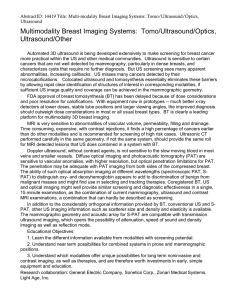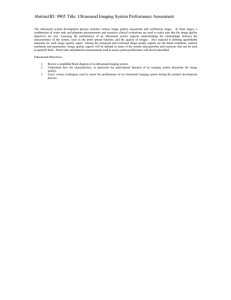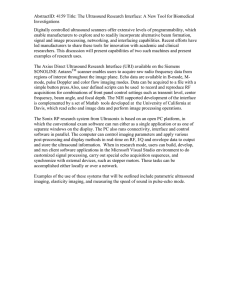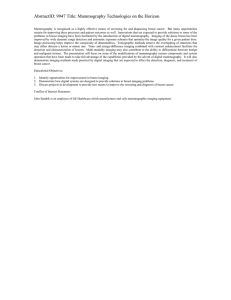011 AAPM Abstract COMBINED PULSE ECHO, X-RAY TOMOSYNTHETIC, PHOTOACOUSTIC AND
advertisement
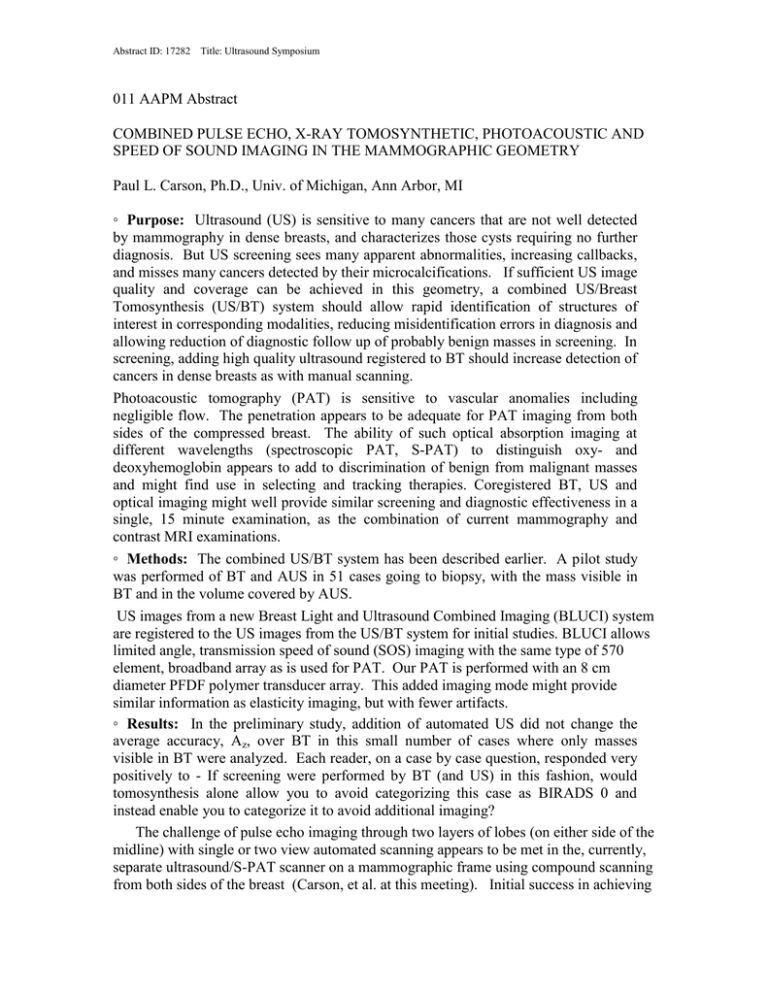
Abstract ID: 17282 Title: Ultrasound Symposium 011 AAPM Abstract COMBINED PULSE ECHO, X-RAY TOMOSYNTHETIC, PHOTOACOUSTIC AND SPEED OF SOUND IMAGING IN THE MAMMOGRAPHIC GEOMETRY Paul L. Carson, Ph.D., Univ. of Michigan, Ann Arbor, MI ◦ Purpose: Ultrasound (US) is sensitive to many cancers that are not well detected by mammography in dense breasts, and characterizes those cysts requiring no further diagnosis. But US screening sees many apparent abnormalities, increasing callbacks, and misses many cancers detected by their microcalcifications. If sufficient US image quality and coverage can be achieved in this geometry, a combined US/Breast Tomosynthesis (US/BT) system should allow rapid identification of structures of interest in corresponding modalities, reducing misidentification errors in diagnosis and allowing reduction of diagnostic follow up of probably benign masses in screening. In screening, adding high quality ultrasound registered to BT should increase detection of cancers in dense breasts as with manual scanning. Photoacoustic tomography (PAT) is sensitive to vascular anomalies including negligible flow. The penetration appears to be adequate for PAT imaging from both sides of the compressed breast. The ability of such optical absorption imaging at different wavelengths (spectroscopic PAT, S-PAT) to distinguish oxy- and deoxyhemoglobin appears to add to discrimination of benign from malignant masses and might find use in selecting and tracking therapies. Coregistered BT, US and optical imaging might well provide similar screening and diagnostic effectiveness in a single, 15 minute examination, as the combination of current mammography and contrast MRI examinations. ◦ Methods: The combined US/BT system has been described earlier. A pilot study was performed of BT and AUS in 51 cases going to biopsy, with the mass visible in BT and in the volume covered by AUS. US images from a new Breast Light and Ultrasound Combined Imaging (BLUCI) system are registered to the US images from the US/BT system for initial studies. BLUCI allows limited angle, transmission speed of sound (SOS) imaging with the same type of 570 element, broadband array as is used for PAT. Our PAT is performed with an 8 cm diameter PFDF polymer transducer array. This added imaging mode might provide similar information as elasticity imaging, but with fewer artifacts. ◦ Results: In the preliminary study, addition of automated US did not change the average accuracy, Az, over BT in this small number of cases where only masses visible in BT were analyzed. Each reader, on a case by case question, responded very positively to - If screening were performed by BT (and US) in this fashion, would tomosynthesis alone allow you to avoid categorizing this case as BIRADS 0 and instead enable you to categorize it to avoid additional imaging? The challenge of pulse echo imaging through two layers of lobes (on either side of the midline) with single or two view automated scanning appears to be met in the, currently, separate ultrasound/S-PAT scanner on a mammographic frame using compound scanning from both sides of the breast (Carson, et al. at this meeting). Initial success in achieving Abstract ID: 17282 Title: Ultrasound Symposium rapid, full acoustic coupling in humans, and in performing PAT and SOS imaging of breast phantoms and specimens will be presented. PAT revealed simulated vessels to 5 cm depth. SOS shows a cylindrical object with the expected resolution of limited angle tomography. ◦ Conclusion: Essentially full, high resolution pulse echo coverage of the breast and large volume PAT (~ an 8 cm diameter cylinder) appear possible in reasonable exam times. The promise of these particular 3 modalities in the mammographic geometry and the level of our current systems justifies initiation of an enhanced screening study of US/BT, with SOS and/or PAT added as method development and exam times allow.

